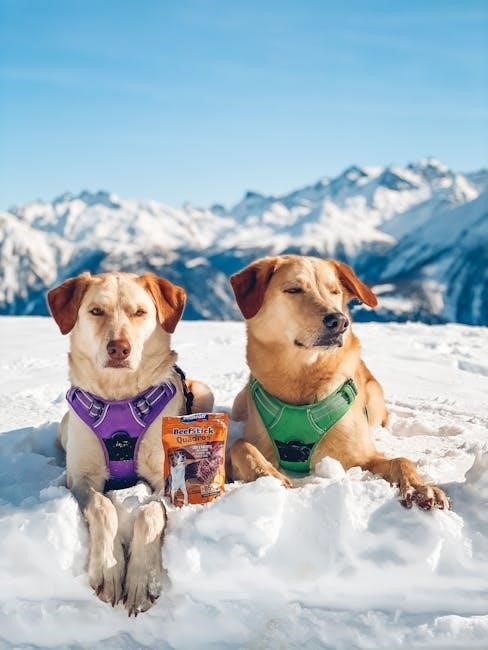Certain human foods can be hazardous to dogs, causing severe health issues or even death. Understanding which foods are toxic is crucial for pet safety and prevention.
Understanding the Risks of Toxic Foods
Toxic foods pose significant risks to dogs, as their metabolism differs from humans, making them more susceptible to harmful substances. Common culprits include chocolate, grapes, and onions, which can cause severe health issues. Chocolate contains theobromine, lethal in high doses, while grapes can lead to kidney failure. Onions and garlic disrupt red blood cells, causing anemia. Artificial sweeteners like xylitol trigger rapid insulin release, risking liver failure. Even small amounts of these foods can provoke vomiting, diarrhea, or more severe symptoms like seizures or organ damage. Early recognition of toxicity signs is critical for effective treatment. Understanding these risks helps pet owners prevent accidental poisoning by securing toxic items and educating themselves on safe dietary choices for their dogs.
Why Dogs Are Susceptible to Food Toxicity
Dogs are more vulnerable to food toxicity due to their unique physiology and metabolism. Their smaller body size means even minimal amounts of toxic substances can be harmful. Dogs metabolize certain compounds differently than humans, leading to quicker accumulation of toxins in their system. For instance, theobromine in chocolate is harmless to humans but toxic to dogs because they metabolize it slowly. Additionally, dogs have a shorter digestive tract, which can result in faster absorption of harmful substances. Their liver may also lack specific enzymes to break down certain toxins efficiently. Furthermore, dogs often eat indiscriminately, increasing the risk of consuming dangerous items. These factors combined make dogs more susceptible to food toxicity, emphasizing the need for careful monitoring of their diet to ensure their safety and health.

Common Toxic Foods for Dogs
Dogs must avoid chocolate, grapes, raisins, sultanas, and currants due to their toxic effects. Other dangerous foods include artificial sweeteners, onions, garlic, and macadamia nuts.
Chocolate and Its Dangers
Chocolate is one of the most common and dangerous toxic foods for dogs. It contains theobromine, a compound that can cause severe health issues in dogs. The darker the chocolate, the higher the theobromine content, making it more toxic. Symptoms of chocolate poisoning include vomiting, diarrhea, increased heart rate, and restlessness. In severe cases, it can lead to seizures, heart failure, or even death. The severity depends on the type of chocolate, the amount consumed, and the dog’s size. Preventing access to chocolate is crucial, as even small amounts can be harmful. If you suspect your dog has ingested chocolate, contact a veterinarian immediately for treatment. Always keep chocolate and cocoa products out of your dog’s reach to ensure their safety and well-being.
Grapes, Raisins, Sultanas, and Currants
Grapes, raisins, sultanas, and currants are highly toxic to dogs, with even small amounts causing severe health issues. The exact toxin responsible is unknown, but their consumption can lead to acute kidney failure. Symptoms include vomiting, lethargy, diarrhea, and lack of appetite, progressing to seizures or coma in severe cases. All forms, including dried and cooked, are dangerous. The risk varies among dogs, with some experiencing immediate reactions while others may tolerate small amounts. Preventing access to these foods is essential. If ingestion occurs, seek veterinary help immediately. Prompt treatment, such as inducing vomiting or administering activated charcoal, can improve outcomes. Always store these foods securely to protect your dog from potential poisoning. Awareness and caution are key to maintaining their health and safety.
Artificial Sweeteners (Xylitol)
Xylitol, a popular artificial sweetener, is extremely toxic to dogs. Commonly found in sugar-free gum, candies, baked goods, and even peanut butter, it causes a rapid drop in blood sugar and can lead to liver failure. Symptoms include vomiting, seizures, and lethargy, progressing quickly. The exact mechanism of toxicity is unique to dogs, as xylitol triggers a massive insulin release. Even small amounts can be fatal, making immediate veterinary intervention crucial. Preventing access to products containing xylitol is vital. Always check food labels carefully and store these items securely. If ingestion occurs, contact your vet or a pet poison hotline immediately for guidance. Prompt treatment, such as administering dextrose or supportive care, can help manage the condition. Awareness of xylitol’s dangers is key to protecting your dog’s health.
Onions and Garlic

Onions and garlic, belonging to the Allium family, contain compounds that are toxic to dogs. These compounds damage red blood cells, leading to anemia. Cooked, raw, or powdered forms are equally hazardous, and even small amounts can cause harm. Symptoms include vomiting, diarrhea, lethargy, and pale gums. Severe cases may result in rapid breathing and collapse. Preventing access to foods containing onions or garlic is essential. Always check ingredients in processed foods, soups, and broths. If ingestion occurs, seek veterinary care immediately. Prompt treatment, such as inducing vomiting or administering supportive care, can help mitigate the effects. Awareness of these common kitchen staples’ dangers is critical to safeguarding your dog’s health and preventing potentially life-threatening complications.
Macadamia Nuts
Macadamia nuts are highly toxic to dogs and can cause severe symptoms, including weakness, depression, vomiting, tremors, and hyperthermia. The exact toxin responsible for this reaction is unknown, but even small amounts can trigger these effects. Symptoms typically develop within 3 to 12 hours of ingestion and can last up to 48 hours. While the condition is usually not fatal, it can cause significant discomfort for your dog. It is crucial to keep macadamia nuts and any products containing them out of your dog’s reach. If you suspect your dog has ingested macadamia nuts, contact your veterinarian or a pet poison hotline immediately for guidance. Prompt action can help ensure your dog’s recovery and prevent prolonged distress.
Caffeine and Alcohol
Caffeine and alcohol are both highly toxic to dogs, even in small amounts. Caffeine, found in coffee, tea, energy drinks, and some medications, can cause hyperactivity, vomiting, heart palpitations, and seizures in dogs. Alcohol, present in beverages, desserts, and fermented foods, can lead to vomiting, diarrhea, difficulty breathing, and even coma or death if consumed in large quantities. Both substances affect dogs rapidly due to their rapid absorption into the bloodstream. The severity of symptoms depends on the amount ingested and the size of the dog. If you suspect your dog has consumed caffeine or alcohol, seek immediate veterinary care, as prompt treatment is essential to prevent serious health complications. Always keep these substances out of your dog’s reach to ensure their safety and well-being.
Salt and Salty Foods
Salt and salty foods can be dangerous for dogs, leading to a condition called hypernatremia, which is an excessive concentration of sodium in the blood. Symptoms of salt toxicity include excessive thirst, vomiting, diarrhea, and lethargy. In severe cases, it can cause seizures, coma, and even death. Dogs are particularly sensitive to high sodium levels, and even small amounts of salty foods, such as pretzels, chips, or soy sauce, can be harmful. It’s important to avoid feeding dogs salty human snacks and to ensure they always have access to fresh water to prevent dehydration. If you suspect your dog has ingested a large amount of salt, seek veterinary attention immediately to address potential complications and restore electrolyte balance. Preventing access to salty foods is key to safeguarding your dog’s health and well-being.

Natural Toxins in Foods

Natural toxins, like cyanogenic glycosides in cassava and stone fruits, can be harmful to dogs if not properly prepared. These plant-derived compounds act as defense mechanisms.
Cyanogenic Glycosides in Plants
Cyanogenic glycosides are natural toxins found in over 2,000 plant species, including cassava, stone fruits, bamboo roots, and almonds. These compounds release cyanide during metabolism, posing risks to dogs if ingested in toxic amounts. While some plants are safe when cooked or processed, others remain hazardous. Symptoms of cyanide poisoning in dogs include vomiting, lethargy, and respiratory distress. Pet owners should avoid feeding their dogs these plants or plant-based foods without proper preparation. Early veterinary consultation is crucial if poisoning is suspected, as prompt treatment can prevent severe health complications. Understanding these natural toxins is essential for safeguarding pets from accidental ingestion of harmful plant materials.
Raw Kidney Beans and Phytohemagglutinin
Raw kidney beans contain phytohemagglutinin, a natural toxin that can cause severe gastrointestinal distress in dogs. When not properly cooked, these beans retain high levels of the toxin, which can lead to vomiting, diarrhea, and abdominal pain. Dogs are particularly sensitive to phytohemagglutinin, and even small amounts can trigger symptoms. Cooking kidney beans thoroughly breaks down the toxin, making them safer for consumption. However, pet owners should avoid feeding raw or undercooked kidney beans to their dogs to prevent potential health risks. It is crucial to ensure all beans are fully cooked before considering them as a safe treat for pets. Proper preparation is key to minimizing the risk of toxicity from this common ingredient.

Symptoms of Food Poisoning in Dogs
Symptoms include vomiting, diarrhea, lethargy, loss of appetite, and abdominal pain. Severe cases may involve seizures, tremors, or difficulty breathing, requiring immediate veterinary attention.
Common Signs of Toxicity
Dogs exposed to toxic foods often exhibit vomiting, diarrhea, lethargy, loss of appetite, and abdominal pain. More severe cases may include seizures, tremors, or difficulty breathing. These symptoms can progress rapidly, leading to life-threatening conditions if not addressed promptly. The severity of the reaction often depends on the type of toxin and the amount consumed. Recognizing these signs early is crucial for providing timely veterinary intervention. Pet owners should remain vigilant, as some toxins can cause sudden and dramatic declines in a dog’s health. Always monitor your dog’s behavior after eating and seek professional help immediately if toxicity is suspected. Early detection and treatment significantly improve outcomes for dogs affected by food poisoning.
Emergency Response to Poisoning
If you suspect your dog has ingested a toxic food, act quickly and remain calm. Contact your veterinarian or a pet poison hotline immediately for guidance. Do not induce vomiting unless instructed by a professional, as this can sometimes worsen the situation. Provide detailed information about the toxin consumed, including the amount and time of ingestion. Keep the packaging or remains of the suspect food handy for identification. Seek urgent veterinary care, as prompt treatment significantly improves outcomes. Time is critical in cases of poisoning, and delaying action can lead to severe health complications or even death. Always have emergency contact numbers readily available to ensure rapid response. Your quick actions can make a lifesaving difference for your dog.

Prevention and Safety Tips
Secure toxic foods, read labels carefully, and educate guests about dangerous items. Store treats safely and use pet-safe alternatives to avoid accidental ingestion of harmful substances.
Secure Food Storage and Disposal
Properly storing and disposing of food is essential to prevent accidental ingestion of toxic substances by dogs. Use airtight containers for all potentially hazardous foods, such as chocolate, grapes, and onions, and keep them out of your dog’s reach. Store these items in high cabinets or locked pantries to ensure your pet cannot access them. When disposing of food waste, use sealed trash cans with tight-fitting lids to prevent curious dogs from rummaging through garbage. Regularly clean up crumbs and spills to avoid temptation. Additionally, educate family members and guests about the dangers of leaving toxic foods unattended. By taking these precautions, you can significantly reduce the risk of your dog encountering harmful substances.
Reading Food Labels Carefully
Reading food labels is a critical step in protecting your dog from toxic substances. Many everyday foods contain ingredients like chocolate, xylitol, onions, and grapes, which are harmful to dogs. Always check the ingredient list for these potential threats. Be aware of alternative names, such as “artificial sweeteners” for xylitol or “dried fruit” for raisins. Even small amounts of these substances can cause severe health issues. Pay attention to warning labels or allergen information, as they often highlight problematic ingredients. If unsure about a product, err on the side of caution and avoid it. Teaching family members and caregivers to read labels carefully can also help keep your dog safe from accidental ingestion of toxic foods.
